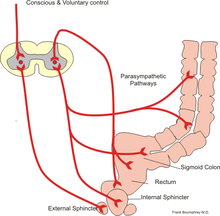Defecation reflex
The defecation reflex (also stool reflex ) is a composite reflex that regulates the storage function of the rectum and the bowel movement . The defecation reflex has an involuntary and an arbitrary component.
Anatomical background
The rectum is closed by two sphincter muscles . The internal anal sphincter muscle (internal anal sphincter ) strengthens the smooth muscles of the circular muscle layer of the intestinal wall and cannot be influenced arbitrarily, but is regulated by the autonomic nervous system . The muscle sphincter ani externus (external anal sphincter ), on the other hand, consists of skeletal muscles and is innervated by the nervus pudendus . It is also subject to arbitrary control by the cerebral cortex .
For the defecation (See paragraph) not only the relaxation of this sphincter is necessary, but also the increase in abdominal pressure caused by skeletal muscles ( abdominal muscles , diaphragm ) is triggered.
Reflex sequence
The increased filling in the rectum irritates the stretch receptors in the rectal wall. Via afferents (nerve tracts leading to the central nervous system) this stretching stimulus is conducted to the spinal cord, more precisely to the sacral cord. Here there is a switch to efferents (nerve tracts leading away from the central nervous system) of the parasympathetic nervous system . These trigger a reflex relaxation of the internal anal sphincter. At the same time, a reflex tension of the external anal sphincter is triggered by the sacral medulla via tracts of the motor nervous system , which prevents the chair from moving. The increased pressure in the rectum causes an urge to defecate.
After about 30 to 60 seconds, the rectum adapts to the increased filling when the droppings are suppressed. The bowel tension is reduced and the stretch receptors are set to a higher threshold value so that the urge to defecate disappears again. An adult can suppress the heel of the chair up to a volume of about one liter.
Disruptions
When the spinal cord is transected ( paraplegia ) above the sacral cord, the defecation reflex is retained at the spinal cord level, but chair heel cannot be triggered due to the lack of the voluntary component. An emptying of the bowels is then only possible through suppositories , enema and / or digital clearing out .
